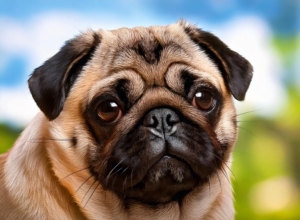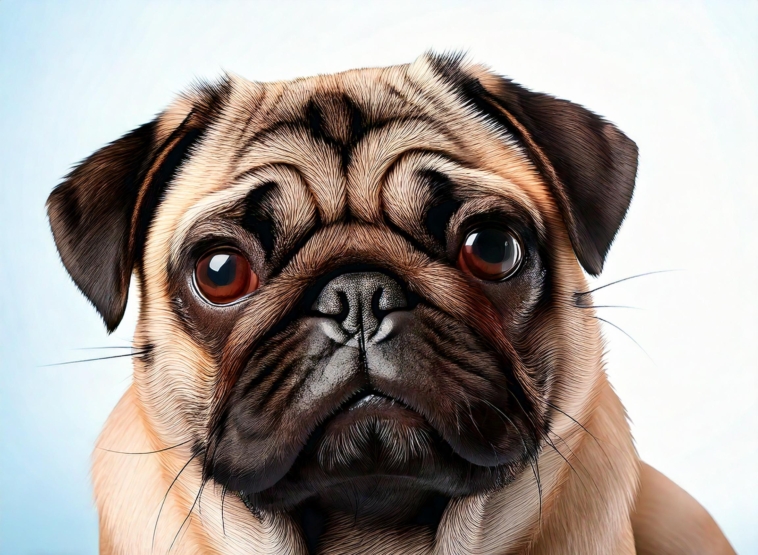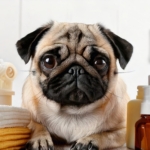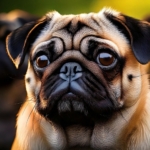The Pug Life: A Snort-Filled Guide to Health and Happiness
Having a pug is like cohabiting with a snorting, snack-snatching, wrinkle-faced gremlin who just so happens to be your best friend. But where there is great cuteness, there is great responsibility. These little couch potatoes come with some big-time health demands. So here it is: your definitive guide to keeping your pug happy, healthy, and side-splittingly well looked after.
Respiratory Drama: Breathing Like a Tiny Steam Engine
Flat faces are cute, but they have a price tag. Your pug likely snores louder than a human and wheezes like an asthmatic tea kettle.
- Wheezing or sounding winded? Time at the vet.
- Steer clear of long walks in warm weather. A brisk breeze and short walks are more their style.
- Don’t look for them to jog. A slow shuffle is more their style.
Weight Watchers: The Battle Against the Bulge
Pugs will inhale a crumb like it is a gourmet feast. Unfortunately, their metabolism is not as excited.
- Supply real food. Not your last night’s spaghetti.
- Treats must be earned, not distributed like party favors.
- Exercise every day — in mind a “leisurely stroll” rather than a “fitness bootcamp.
Wrinkle Maintenance: The Fold Patrol
Every cute wrinkle is a germ trap waiting to happen. Wipe them clean, it isn’t glamorous work, but neither is an infection on the face.
- Gaily wipe-downs. It’s spa day, whether they want it or not.
- When their face begins to reek of sour milk, things are not good.
- Make it dry and clean, or pay for a whole lot of vet bills.
Mental Health: For the Quirky Little Brain
Pugs are needy, emotional, and affectionate. Essentially, small, fuzzy roommates who don’t contribute to rent.
- Play with them. Or they’ll chew your shoes in protest.
- Socialization is essential. Don’t let them become cranky gremlins.
- Puzzle toys keep their brains as busy as their wagging tails.
The Pug Diet: Not All Bacon and Burgers
Pugs eat like every meal might be their last. You’ll need to intervene before your pet becomes a meatball with legs.
- Protein first: chicken, beef, fish – not “flavor dust.”
- Healthy fats = shiny coat, not greasy disaster.
- Fiber keeps things moving in the digestive department.
- Control portions. Their pleading eyes are lying to you.
Exercise for the Elegantly Lazy
Pugs aren’t really designed to be fast. They’re designed to take naps, graze, and roll over on their backs for belly rubs.
- Short strolls, not mountain trails.
- Games indoors are wonderful, the more that allow you to sit the better.
- Swimming is okay, provided you can be the lifeguard.
- Jumping and boisterous play? Save that for the younger, longer-legged bunch.

Grooming: The Maintenance Schedule of a Wrinkly Celebrity
Pugs shed as if it were their job. They have serious grooming requirements—unless you like tumbleweeds of fur and enigmatic odors.
- Weekly brushing to manage the fur storm.
- Bathe monthly, or when they reek like an old sock.
- Wrinkle cleaning must be a daily procedure.
- Nail clipping every other week. If you hear clicking, it’s too late.
- Ears and teeth require attention as well—check on them regularly unless you enjoy vet surprises.
The Vet: Your Pug’s Other Best Friend
No offense, but you’re not a licensed vet. That’s why regular check-ups are important—especially when your pug’s default is “snore and wobble.”
- At least annual check-ups. Twice yearly if they’re elder.
- Stay current on vaccines unless you want to hear about canine flu the hard way.
- Dental visits = less tooth extractions and fresher breath.
- Weight and parasite checks regularly are a must.
Preventive Health: Because Pugs Don’t Come with Warranties
You can’t bubble-wrap your pug, but you can be ahead of the curve with some good ol’ prevention.
- Preventative health screenings for typical pug conditions: hip dysplasia, eye disease, brachycephalic syndrome.
- Parasite management—fleas and ticks adore pugs just like you do.
- Keep vaccines up to date. No one likes a pug with kennel cough.
The Right Living Space: Pug-Proofing 101
A good home environment equals fewer injuries, less overheating, and more snuggly naps.
- Use fans or AC when it’s hot outside. Pugs are essentially walking heat traps.
- Soft, machine-washable bedding is the way to go. Think orthopedic, not decorative.
- Hydration is not optional. Have water available at all times.
- No toxic plants, wires, or snack caches within reach. They will find them.
Senior Pug Life: The Golden Years
Old pugs are snortier, slower, and even more adorable. And they require special TLC, though.
- Vet visits = more often, less voluntary.
- Diet = high quality, low-calorie, and arthritic-friendly.
- Exercise = short walks and plenty of snoozes.
- Behavior changes? Don’t dismiss them—consult the vet.
- Spend the money on a good bed. You try sleeping on stiff joints with a bargain cushion.
Going Holistic (Without Going Full Hippie)
Occasionally your pug may need some less than traditional care.
- Acupuncture: Yes, dogs can even get needled. It’s not strange.
- Massage: Circulates blood and makes them feel like royalty.
- Herbs and oils: Vet-approved only. Don’t treat your pug like a guinea pig.
- Aromatherapy: Lavender to calm nerves. Just don’t do it too much.
Final Thoughts: Living the Best Pug Life
Your pug may be teeny, snorty, and folded to the max—but they’re also your faithful, wiggly shadow. It’s effort to keep them healthy, but it’s worth every snuffle and snore.
- Feed them as if you adore them, not as if you’re paying them off.
- Exercise them regularly, but don’t push them like they’re an Olympic athlete.
- Clean those folds seriously.
- Take the vet visit before your pug gives you the “I told you so” look.
Take good care of their body, love their quirky little personality, and they will return the favors with years of snuggling, laughter, and precisely timed passing of gas.




